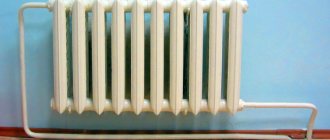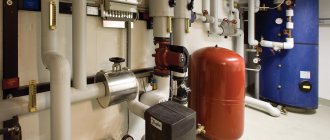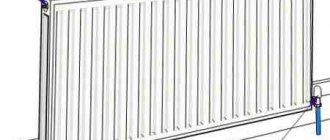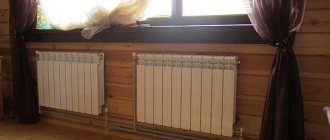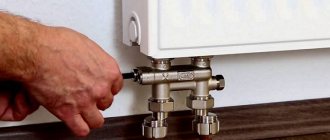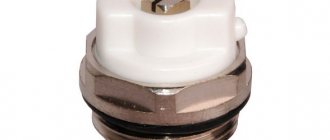The technical passport for the heating device indicates all the main characteristics, including the inter-nipple distance. Usually this parameter is also in the model name (indicated by numbers). Sometimes experts call it not only the inter-nipple distance, but also the center-to-center or connection distance.
But all these are just different “names” of a quantity that determines the distance between the centers (axes) of the input and output collectors of a device or a separate section.
Center distance of radiators
The radiator center distance is the distance measured between the inlet and outlet of the collectors and, accordingly, the pipes. The most common dimensions of the center distance are 350 and 500 mm. At the same time, some manufacturers produce radiators with center distances of 300 mm, 450 mm, and 600, 800 mm. The greater the interaxal distance of the radiator, the greater the power of its sections and weight. This is one of the most important parameters by which a radiator is selected for a particular system. The height of the equipment depends on the center distance. possibility of its installation.
How to choose the size of a heating radiator
The selection of battery size is as follows. After making sure that the products from the manufacturer that suits you are suitable in height and depth, you need to find out the number of sections for each room. To do this, we calculate the required thermal power of heating devices using the algorithm:
- in a room with one external wall and 1 window, 100 W of heat is received per 1 m2 of its area;
- if there are two walls facing outside, then you need to take 120 W per 1 m2 of room;
- when there are 2 walls and 2 windows, then 130 W/m2.
Note. The algorithm will give the correct result for rooms up to 2.5-2.7 m high. If the ceilings are higher, it is recommended to take 40 W of heat per 1 m3 of room volume.
Multiplying these figures by the area of the rooms, we obtain the required thermal power, from which we determine the size of the battery, taking the heat transfer of 1 section as a basis. Below, as an example, are tables showing all sizes, center distances and heat transfer of aluminum and bimetallic GLOBAL radiators:
As a rule, the values of the thermal power of the sections are indicated taking into account that the difference between the average temperature of the coolant and the air in the room is 70 ˚С (in the passport it is written: at DT = 70). This means that at +22 ˚С in the room the supply water temperature should be about 100 ˚С, while in a private house it is rarely 70 ˚С.
And at this temperature, the battery section will give off 30% less heat, which should be taken into account.
Advice. In order not to make a mistake, you need to subtract 30%, or better yet, 50% from the power indicated in the product passport.
Having determined the real power of 1 section, it becomes clear how to find their number: divide the previously found heat consumption by this value. But after this, you may encounter a situation where the heater assembly does not fit into the window sill niche or, conversely, looks too unpresentable in it, as shown in the photo:
How to choose the battery size in such cases? If it does not fit under the window, then the solution is simple: you need to divide the number of sections into 2 parts, instead of one device you will get two. The length of the first will be 75% of the window opening, and the second will be all that remains. This part can be placed near the side wall, connecting pipelines to it. In the opposite situation (as in the photo), you need to take sections with a smaller center distance and height. Their heat transfer is less, which means that the total length of the heater after recalculation will increase, and as a result it will look great.
General overview of radiator types and their dimensions
There are several main groups of heating batteries, differing in design features:
- Sectional.
- Panel made of steel and bimetallic.
- Convector.
- Author's models , made to order, having unique shapes, but performing their functions.
The photo shows the original heating device
The material used and the design features of the heating devices determine:
- resistance to water hammer;
- corrosion;
- clogging and scale deposits;
- heat transfer intensity and other components of success.
As for the size, the difference in height between the upper and lower collector (center distance) affects the possibility of installing the heating device. Most often they are installed in niches under windows; if the window opening is large enough, then the high battery simply will not fit.
The diagram shows the center distance
This parameter is especially important for systems with natural circulation. The fact is that the pressure in the system is created due to the difference in height between the water supply to the battery and the boiler; the greater this value, the greater the natural pressure in the pipes.
Note! For example, it makes sense to choose a center-to-center distance of 250 mm for heating radiators only for very low window sills. In this case, it will be possible to install batteries even under a window sill 50-60 cm high.
Example of a battery in a room with large windows
Panel heating devices are an all-welded structure with a coolant coil between two ribbed panels with a gap between them of up to 1 cm. Such a surface increases the area of the heated surface and its heat transfer - radiation plus convection. The meager capacity promotes rapid heat transfer - the efficiency reaches 75%, but they also cool down quickly.
What is the center distance in heating radiators:
The distance between the radiator collectors is one of the important characteristics on which the dimensions of the product depend. Dimensions affect the possibility of installation, especially if the battery is planned to be placed in a niche or under a window. The correctly selected product size will not violate the main operational standards on which normal heat transfer depends.
A non-specialized overview of their dimensions and types of radiators
It is possible to distinguish a couple of main groups of heating batteries, differing in design features:
- Sectional.
- Panel made of steel and bimetallic.
- Convector.
- Author's models , made to order, having unique shapes, but performing their functions.
The design features and material of the heating devices used determine:
- resistance to water hammer;
- corrosion;
- scale deposits and clogging;
- heat transfer intensity and other components of success.
As for the size, the difference in height between the upper and lower collector (center distance) affects the possibility of installing the heating device. Much more often they are installed in niches under windows; if the window opening is large, then the high battery simply will not fit.
This parameter is especially serious for systems with natural circulation. The fact is that the pressure in the system is created due to the difference in height between the water supply to the battery and the boiler; the greater this value, the greater the natural pressure in the pipes.
Note! For example, the center distance of heating radiators of 250 mm should be chosen only for low window sills. Under such conditions, it will also be possible to install batteries under a window sill 50-60 cm high.
Panel heating devices are an all-welded structure with a coolant coil between two ribbed panels with a gap between them of up to 1 cm. Such a surface increases the area of the heated surface and its heat transfer - radiation plus convection. The meager capacity promotes rapid heat transfer - the efficiency reaches 75%, but they also cool down quickly.
The disadvantages of panel products include:
- their vulnerability to water hammer, which makes them unsuitable for use in central heating systems;
- corroded by acidic water;
- It is forbidden to drain water for a long time due to the same corrosion, but in contact with oxygen.
Sectional batteries are good for the possibility of their constructive transformation - increasing/decreasing the number of sections for power transformation or repair. The classic brittle but durable cast iron with high inertness has been replaced by bimetallic devices.
In them, the coolant passes through metal tubes with aluminum fins, which have high thermal conductivity.
A bimetallic battery is the embodiment of two advantages in one product, in particular:
- steel can withstand unstable pressure and aggressive environments;
- aluminum responds instantly to temperature transformations.
Note! The only drawback that can be noted is the price. The price of a bimetallic radiator can be several times higher than an analogue made of cast iron or steel.
When choosing bimetallic batteries, you also have to take into account the diameter of the vertical and horizontal channels, and not just the interaxal distance. As for the dimensions, the most popular models can be considered with a difference between the nipple holes of 500 mm (along with this, the total height of the heating device is 570 mm).
But in vacuum batteries the concept of “center distance” does not exist. The fact is that they use only 1 flow pipe through which the coolant circulates, and uniform heating of the surface is achieved through the evaporation of a low-boiling liquid.
Tubular battery registers are superior to sectional ones in terms of variety and compactness of shapes. The absence of leaks at the joints is ensured by welding the fragments; they can withstand operating pressures of up to 15 atm, but narrow walls do not withstand water hammer well. It is entirely possible to make registers with your own hands by choosing an arbitrary path between the pipes.
More information about radiator dimensions
In addition to the thermal power, the technical documentation for heating devices must also indicate dimensions and center distance. Depending on the type and manufacturer, the dimensions of heating devices may vary
Bimetallic radiators
Of all battery dimensions, the distance between the collectors can be considered decisive - the size of the product depends on it.
And if the length of sectional devices can be varied, then the height can become a bone of contention. This parameter is indicated by a number at the end of the model name, for example, ALUX 200.
The standard center-to-center distance for aluminum radiators is 350 and 500 mm, but this figure can vary from 200 to 800 mm.
For example, in the Italian sectional models ALUX 200, with a uniform height of 245 mm and a depth of 100 mm, any section 80 mm long has a power of 92 W. The large length forms 1280 mm (16 sections) with a power of 1472 W. Model ALUX 350 with a height of 395 mm has the same number and dimensions of sections, with a power of 138 W, ALUX 500 has a height of 545 mm with a section power of 179 W.
The usual size range for bimetallic batteries includes center distances from 200 to 500 mm. But the height of the device may vary slightly depending on the manufacturer. For example, with this parameter set to 500 mm, the Rifar Monolit has a height of 577 mm, and the Germanium Neo model has a height of 560 mm.
Bimetallic radiators with a center distance of 450 mm are not produced. So you will need to purchase a heating device that is closest in size.
Note! If the height of the pipes does not correspond to the center distance, it is always possible to bring them together or separate them. It is only fundamentally important that the transition be smooth, and not at an angle of 90?.
The design of a bimetallic radiator provides, in addition to 2 horizontal tubes, also narrower vertical metal tubes through which the coolant circulates. But low models may not have them. For example, if the height of the heating device is about 20 cm, it will warm up perfectly even from 2 horizontal pipes.
Cast iron radiators
Such models are considered classics and have been in use for more than 150 years; it goes without saying that the appearance has been changed, but the idea itself remains a thing of the past. A separate standard has also been issued for this type of battery - GOST 8690-94.
In accordance with this document, the range of distances between nipple holes ranges from 300 to 800 mm, while the total height of the device ranges from 400 to 900 mm.
As for the varieties of such heating devices, models with 1, 2 and 3 channels are available, in addition, the shape of the sections themselves may vary. To avoid confusion when choosing a battery, it is easy to know the specific markings of the device.
In accordance with GOST 8690-94, when marking, the following radiator parameters are indicated:
- its depth;
- the distance between the central axes of the nipple holes;
- since the pressure in the heating system is high, the high operating pressure must be recorded in the marking;
Note! Cast iron is a brittle material, so it does not withstand water hammer well. If such phenomena occur in the heating system, then it is better to abandon cast iron batteries and choose a metal or bimetallic analogue.
- the number of sections and the standard used are indicated.
If you need to select the center-to-center distance of a heating radiator of 450, then it is possible to select a battery with the closest value of this parameter, 400 mm, and bring the pipes together a little. The standard does not provide for the production of heating devices with a distance between nipple holes of 450 mm.
In most cases, the marking also indicates the thermal power of one section. For example, the entry MS-140M-500-0.9 indicates that one section is capable of producing 140 W of heat, the center distance is 500 mm, and the operating pressure is 9 atmospheres.
Aluminum radiators
The main difference between aluminum radiators and bimetallic ones is that the tubes and frame through which the coolant moves are made of aluminum alloy. In bimetallic ones, they are made of steel or copper, and aluminum is used only for fins.
As for the size range, the minimum value can be considered 150 mm, and the upper threshold is limited to 800 mm between the axes of the nipple holes.
The battery power also changes according to the size:
- a 150 mm high piece is suitable for houses with huge windows; it will not block the view from the window. The set comes with legs so you don’t have to attach it to the wall;
- large sizes of 700-800 mm have high heat transfer due to the developed surface of the radiator;
- but the most popular sizes can be considered 400-500 mm between the axes of the nipple holes. These are the batteries that are used in most apartments.
It is worth highlighting vertical heating radiators separately. If placing a heating device under a window is not entirely comfortable, then the instructions for decorating the room allow for placing a vertical radiator in the corner. It is quite small in width (almost 5-7 sections), but the height can be about 2 meters.
With aluminum radiators, the center distance is from 1200 to 2000 mm. Indeed, the efficiency of such a battery when compared with a simple one is slightly lower, since part of it is located in the upper part of the room, where the temperature is slightly higher than that of the floor.
Dimensions of metal radiators
The overall dimensions of panel metal radiators are in the range of 20 – 90 cm, and the interaxial distance is 5-7 cm less than the height. Devices are produced with an interaxial distance of 450 mm; cast iron and bimetallic analogues do not have this standard size.
Metal radiators will also be vertical; a greater height under such conditions is possible, 2-3 meters. But simpler models are more often used.
In addition, registers are made from metal pipes (this is explained by its welding, the strength and lightness of steel). But there are no restrictions on the type of heating devices, and the diameter is selected based on the client’s thirst and the heat output of the heater.
In conclusion
Center distance is a critical parameter in any modern radiator. The height of the device depends on this size, and accordingly the possibility of installing it in a niche under the window. The range of standard sizes of modern radiators will allow you to install them both in a simple apartment and under a huge window.
This article contains a sequence of necessary tips for choosing a heating radiator for your home.
Construction of bimetal radiators
This type of radiator is the result of combining two metals. The internal part (base) of the product has the shape of a steel frame, inside of which the coolant itself is installed directly, from which heat enters the atmosphere. The strength of steel allows it to withstand powerful pressure in the heating network, and its coating protects the product from corrosion.
The outside of the frame is covered with an aluminum shell (casing). Aluminum has good thermal conductivity, heats up quickly and conducts heat coming from the heating network. The outer shell is made up of fins to direct warm air into the room.
Types of bimetallic radiators
There are two main types:
- Cast or monolithic. The heater body is cast in a special mold.
- Sectional or prefabricated. The structure is assembled from separate sections using threaded connections.
The dimensions of the prefabricated radiator can be expanded by adding additional sections. A cast (monolithic) radiator cannot be expanded, but there are ready-made options with a wide range of sizes, so you can choose the right one.
On a note! Cast models, unlike prefabricated ones, cost an order of magnitude higher!
To choose a reliable radiator for an apartment, you need to know the structure of the heating network itself. In modern high-rise buildings it is better to install monolithic heaters. They are more resistant to pressure surges in pipes. A sectional model may not withstand such loads due to its special design. However, this type of radiator can be equipped with additional sections, which is necessary in some cases. In addition, it is much easier to maintain.
Semi-metallic radiators
This type of radiator is different in that its base is made not only of steel, but also some of its parts are made of aluminum, which makes the product less durable than the original. Because of this, the quality of the product and durability are sharply reduced. The junction between a steel pipe and an aluminum pipe wears out quickly due to the different degrees of expansion of these two metals when heated. Therefore, semi-bimetallic radiators are much inferior in quality to bimetallic ones.
Semi-bimetallic radiators can be identified by their lightweight. When choosing a radiator, it is worth considering this parameter. Such heaters are more suitable for installation in country houses, as they are similar to aluminum ones.
What is center distance
All bimetallic radiators have a distance between the inlet and outlet. The most common size is 350 mm or 500 mm, but batteries with a distance between the axes of 200 mm or 800 mm can be found on sale.
Product material
The internal frame of bimetallic radiators is made of durable steel alloy, and the outer shell is made of aluminum. The steel base can withstand high pressures in pipes and water hammer. High-quality steel is not subject to corrosion, and the outer casing made of aluminum heats up well and quickly distributes heat throughout the room. High carbon steel has special strength and durability.
What is radiator center distance: dimensions, features, choice
Maintaining a comfortable room temperature directly depends on the size of the heating batteries and the center distance of the radiator.
If there are violations during installation regarding the recommended distances between the radiator and the wall, the heating efficiency is noticeably reduced.
To prevent possible problems, it is recommended to study in advance the features of installing batteries and find out what parameters are considered acceptable for heating devices of various types.
Description of radiator center spacing characteristics
The center-to-center or inter-nipple distance of the radiator is a value indicating the gap between the central parts of the output and input collectors of the entire battery or each of its sections.
It is indicated in the specification for the radiator, where its main characteristics are presented, and is indicated by numbers in the name of the device model. This indicator is of particular importance in private homes where water is naturally contained in the heating system.
If the gap is large, liquid will not stagnate in such a radiator, due to which the efficiency will begin to increase.
Values of 300, 350 and 500 mm are considered standard; many modern manufacturers produce batteries of this type. There are models with other intervals, for example, 200, 400 or 600 mm; in designer batteries this value reaches 2000 mm.
For radiators with the same center spacing, the installation height may be different and depends on the design features of the battery, the material from which it is made, as well as the design and brand.
These values should not be confused, which is especially important when installing radiators in openings under windows or niches.
In Soviet or post-Soviet houses, appliances were more often installed with an interval of 500 mm; for this reason, options with this indicator are still more popular in Russia.
Heating radiator sizes
Based on the type of material, radiators can be bimetallic, steel, aluminum or cast iron. The dimensions, general parameters and weight of the batteries directly depend on this, which must be taken into account when choosing the appropriate option.
In appearance, bimetal batteries resemble aluminum devices, while their output and input collectors, as well as vertical heat-conducting channels, are made of stainless steel with an aluminum housing placed on top.
Devices of this type do not rust and are resistant to water hammer, so they are often installed in apartments that are connected to a central heating system.
The list of advantages includes a high level of strength, reliability, resistance to environmental influences, and compatibility with all heating systems.
Section dimensions:
- Center distance: 200 mm, 350 mm, 500 mm.
- Height: 415 mm, 570 mm.
- Width: 80 mm.
- Depth: 75 mm, 85 mm, 90 mm, 100 mm.
Radiators have high heat transfer, do not require a large number of thermal media, and their service life reaches 20-25 years.
They also have their drawbacks, for example, creaking that occurs due to the difference in the expansion coefficients of steel and aluminum.
Vertical channels can become clogged, so their cleanliness must be monitored separately; in addition, bimetallic channels are more expensive than analogues made from other materials.
Aluminum
Dimensions of aluminum radiators
Radiators of this type can be extruded or cast; the second option is more popular, since such devices are highly durable and not subject to corrosion. Aluminum batteries provide optimal thermal output, they are easy to install and transport due to their low weight, and they are also able to heat up as quickly as possible.
The models are available in a variety of designs and represent the optimal combination of cost and heat efficiency. The downside is the potential for damage due to water hammer. There are devices on the market with a gap between the axes from 200 to 800 mm, the most popular options being 350 and 500 mm.
Aluminum units can only be operated if there is no oxidized environment in the coolant, so they are not recommended for installation in buildings with a central heating system.
Steel
Appliances made of steel, including those with side connections, are tubular or panel. Panel-type radiators are a system of 1, 2 or 3 panels with or without fins made of special U-shaped plates.
Each panel includes a pair of steel sheets with channels that are connected to each other by welding.
The advantages of such radiators include increased heat transfer, convenient installation, resistance to damage, safety, reasonable cost and impressive design.
Tubular radiators consist of inlet and outlet manifolds, which are connected to each other using several rows of tubes with a thickness of at least 1.0-1.5 mm. All parts are connected by welding, which leaves no seams.
The list of advantages of tubular radiators includes accelerated heating, resistance to aggressive environments and mechanical loads, water hammer, the ability to choose the shape and color of the battery, safety and environmental friendliness, and no problems during operation.
The distance between the centers of the radiator fittings is 300 or 500 mm. The depth of the product section is from 40 to 115 mm. The thickness of the steel does not exceed 1.5 mm.
Panel devices may not withstand water shocks during system checks and are often subject to corrosion. The disadvantages of tubular radiators include reduced heat transfer, the formation of leaks in welding areas and high cost.
Cast iron
Cast iron batteries are still popular due to their good resistance to high temperatures, lack of corrosion problems and durability.
Devices of this type have extended channels that ensure ideal circulation of the coolant even during clogs.
Cast iron radiators provide an accumulating effect and remain warm for a long time after the coolant supply has been stopped.
Such devices also have their drawbacks, for example, large sizes compared to similar options made from other metals, as well as significant weight, due to which cast iron radiators are equipped with supports. Due to the low thermal output of cast iron, batteries of this type slowly warm up the room. Many models have sections of complex shape, which makes caring for the device more time-consuming.
The height of the radiator section is from 400 to 900 mm, the depth is from 100 to 200 mm. The distance between the centers of the nipple holes is within 300-800 mm.
Advantages and disadvantages of radiators
Modern domestically produced radiators are manufactured taking into account the characteristics of Russian heating systems. Each device has its pros and cons depending on its type. The most popular in Russia are cast iron and aluminum batteries.
Cast iron devices are chosen because of their strength, ability to withstand operating pressure within 6-9 atm and coolant temperature up to 130 degrees.
Their disadvantages include increased thermal inertia, instability to water hammer, installation difficulties due to the large weight of the batteries, and a not very aesthetic design.
Aluminum appliances are in second place in popularity. Designed for pressure in the range of 6-25 atm and coolant temperature up to 130 degrees.
The list of their advantages includes high heat transfer and good heating speed, economical energy consumption, the ability to regulate the room temperature, compact size and no problems during installation, combined with an impressive modern design.
Among the disadvantages of such units, it is worth noting the low capacity for convection, increased formation of gases and a high probability of leakage.
Installation features
Installation diagram
The process of installing a radiator of any type consists of a number of standard steps. First of all, old batteries are dismantled, if any, and places for placing the fasteners are determined, on which the brackets are then fixed.
At the second stage of installation, you need to prepare and hang the battery itself and install shut-off valves, then connect the pipes, observing the center distance in the heating radiators.
It is important to select the correct sizes of heating batteries and install them correctly, regardless of size.
Radiators are placed strictly horizontally or with a slight slope, taking into account the direction of flow of the coolant. In the second case, if clogged, it will be easier to remove air pockets.
You can connect the batteries to the main line from below, from the side or diagonally; a separate valve and Mayevsky tap are installed on each device, which makes it possible to repair the radiator without having to completely disconnect the entire system. The dimensions of the devices should be calculated in advance to determine their available power.
Manufacturer's choice
When choosing a brand, you need to take into account that many foreign radiators may not correspond to the features of Russian heating systems, so experts recommend giving preference to domestic batteries.
The list of the most suitable options includes models from Apriori, Elsotherm, Rifar, Faral and Konner. These are Russian brands that have proven themselves when working in various conditions.
Among foreign manufacturers, experts advise giving preference to batteries from Kermi, IRSAP, Zehnder or Guratec. The devices of these brands are of a high level of quality, made of durable materials and meet international standards.
Method of connecting sections
In bimetallic heating radiators, the sections are connected to each other using steel threaded nipples. In the manufacture of Monolit series radiators from the Rifar company, another type of connection is used - welding. This model of heating devices can withstand increased pressure (operating up to 100 atm) and temperature (up to 135°C versus 110°C for nipple models).
Diagram of a monolithic radiator.
Bimetallic radiators are the most technically advanced heating device for water heating systems. Combining high efficiency and good performance indicators, devices of this type are optimal for use in domestic conditions. Knowing the technical characteristics of bimetallic heating radiators of various models, you can choose a heating device that best suits the operating conditions in a particular room.
Related articles:
When choosing a home heating system, many factors are taken into account: the cost of equipment, safety, installation and maintenance features.
Let's look at repairing an oil heater using a specific example.
To heat houses and apartments, various types of equipment are used, including electrical appliances of various modifications. These are convectors.
When choosing a heating system for any building, it is important to understand the operating principles and features of the equipment in question. This will allow you to choose the most.
Let's talk today about comfort and warmth in the house, be it a private house, apartment or cottage.
Heated surface area and power
The overall intensity of the heat flow directly depends on the area from which it is removed. The more fins, sections, and other features that increase surface area a radiator has, the more heat it produces.
Power, or the rated heat flow of a section, is an indicator for calculations that must be made to assemble a device powerful enough to heat a room. Normally, this indicator is determined as a result of thermal tests. The conditions created during testing are the difference in temperature of the coolant and the external environment (air temperature) of 70°C, coolant flow rate of 0.1 kg/s, barometric pressure of 1013.3 GPa. The radiator assembly is tested, then the rated power of one section is calculated.
What is the center distance in heating radiators?
The distance between the radiator collectors is one of the important characteristics on which the dimensions of the product depend. Dimensions affect the possibility of installation, especially if the battery is planned to be placed in a niche or under a window. The correctly selected product size will not violate the main operational standards on which normal heat transfer depends.
Design Features
For example, cast iron radiators may have various design features, on which all characteristics of the device depend. The design can be single-channel, two-channel or three-channel. The weight, section capacity and steel efficiency indicators of the radiator depend on the type.
Section weight and capacity
In general, the mass of a radiator does not affect its technical characteristics, but it does affect its operational characteristics, because the mass of a heating radiator with an axial distance of 300 will be much less than heating radiators of 500 mm.
The greater the mass of the heating radiator, the more difficult it is to install. For example, heavy cast iron batteries are heavier, so they are difficult to transport and assemble.
If battery repair or cleaning is required, removing the section is more problematic.
Among the characteristics of the radiator, the section capacity may be indicated. For efficiency, this indicator is not as important in itself as the fact that a large capacity means a larger surface from which heat is removed.
But also increasing the capacity of the radiator affects its ability to withstand surges in water pressure. Narrower sections of the system experience greater loads and may fail if there is insufficient strength.
Heated surface area and power
The overall intensity of the heat flow directly depends on the area from which it is removed. The more fins, sections, and other features that increase surface area a radiator has, the more heat it produces.
Power, or the rated heat flow of a section, is an indicator for calculations that must be made to assemble a device powerful enough to heat a room. Normally, this indicator is determined as a result of thermal tests.
The conditions created during testing are the difference in temperature of the coolant and the external environment (air temperature) of 70°C, coolant flow rate of 0.1 kg/s, barometric pressure of 1013.3 GPa.
The radiator assembly is tested, then the rated power of one section is calculated.
Maximum operating and test overpressure
Knowing the pressure in your heating system from instrument readings or information from a service organization, you can determine the value of the radiator test pressure. It should be 1-2 atmospheres higher than the pressure test. It is necessary to compare the pressure indicated in the documents for the device and the pressure that exists in the water system. The difference should be about 2 atmospheres.
Sensitivity to coolant quality
In the technical documentation you can find information about which coolants the radiator can work with. Aluminum radiators are the most demanding in terms of acid-base balance. This indicator for them is 7-8 pH. Having low corrosion resistance, such devices will quickly fail if operating conditions are violated.
It may also be indicated for what coolant temperature this device is intended.
If the coolant flows through the heating system at a low speed, this contributes to the accumulation of contaminants and the gradual clogging of radiators. The rougher the surface of the inside of the radiator, the more connections and corners, the more prone the device is to clogging.
The presence of blockages adversely affects the efficiency of the device, reducing heat transfer. You can restore the performance of the radiator by flushing it. Lightweight aluminum or bimetallic dismountable structures benefit greatly from this.
They are much easier to maintain.
Dimensions and connection type
Since radiators are most often made in a rectangular shape, the overall dimensions of heating radiators include the height, width, and depth of the section.
Among the overall dimensions, the center-to-axle value is distinguished, by which the height of the radiator is determined. For example, heating radiators 350 mm of this value are one of the smallest sizes.
However, for some interiors or for short distances under windows they are the only acceptable solution.
Radiators can be manufactured with bottom or side connections. Since the bottom connection is convenient because in this case you can install a thermostatic valve, the cost of a radiator with a bottom connection will be higher.
What is the center distance in heating radiators: dimensions of bimetallic, cast iron, aluminum and steel devices
The distance between the radiator collectors is one of the important technical characteristics on which the dimensions of the product depend. Dimensions affect the possibility of installation, especially if the battery is planned to be placed in a niche or under a window. The correctly selected product size will not violate the basic operating standards on which normal heat transfer depends.
Heating devices of different heights
General overview of radiator types and their dimensions
There are several main groups of heating batteries, differing in design features:
- Sectional.
- Panel made of steel and bimetallic.
- Convector.
- Author's models , made to order, having unique shapes, but performing their functions.
The photo shows the original heating device
The material used and the design features of the heating devices determine:
- resistance to water hammer;
- corrosion;
- clogging and scale deposits;
- heat transfer intensity and other components of success.
As for the size, the difference in height between the upper and lower collector (center distance) affects the possibility of installing the heating device. Most often they are installed in niches under windows; if the window opening is large enough, then the high battery simply will not fit.
The diagram shows the center distance
This parameter is especially important for systems with natural circulation. The fact is that the pressure in the system is created due to the difference in height between the water supply to the battery and the boiler; the greater this value, the greater the natural pressure in the pipes.
Please note! For example, it makes sense to choose a center-to-center distance of 250 mm for heating radiators only for very low window sills.
In this case, it will be possible to install batteries even under a window sill 50-60 cm high.
Example of a battery in a room with large windows
Panel heating devices are an all-welded structure with a coolant coil between two ribbed panels with a gap between them of up to 1 cm. Such a surface increases the area of the heated surface and its heat transfer - radiation plus convection. The meager capacity promotes rapid heat transfer - the efficiency reaches 75%, but they also cool down quickly.
The disadvantage of panel products is:
- their vulnerability to water hammer, which makes them unsuitable for use in central heating systems;
- corroded by acidic water;
- You cannot drain water for a long time due to the same corrosion, but in contact with oxygen.
Sectional batteries are good for the possibility of their design changes - increasing/decreasing the number of sections to change power or repair. Traditional brittle but durable cast iron with high inertness has been replaced by bimetallic devices.
In the photo - the device of a bimetallic heater
In them, the coolant passes through steel tubes with aluminum fins, which have high thermal conductivity.
A bimetallic battery is the embodiment of two advantages in one product, namely:
- steel can withstand unstable pressure and aggressive environments;
- aluminum reacts with lightning speed to temperature changes.
Please note! The only drawback that can be noted is the cost.
The price of a bimetallic radiator can be 2-3 times higher than an analogue made of cast iron or steel.
When choosing bimetallic batteries, you also have to take into account the diameter of the vertical and horizontal channels, and not just the interaxal distance. As for the dimensions, the most popular models can be considered those with a difference between the nipple holes of 500 mm (the total height of the heating device is 570 mm).
The photo shows the horizontal and vertical channels; if the quality of the coolant is poor, they should not be too narrow
But in vacuum batteries the concept of “center distance” simply does not exist. The fact is that they use only 1 flow pipe through which the coolant circulates, and uniform heating of the surface is achieved through the evaporation of a low-boiling liquid.
Tubular battery registers are superior to sectional ones in compactness and variety of shapes. The absence of leaks at the joints is ensured by welding the fragments; they can withstand operating pressures of up to 15 atm, but thin walls do not withstand water hammer well. It is quite possible to make the registers yourself by choosing an arbitrary pitch between the pipes.
